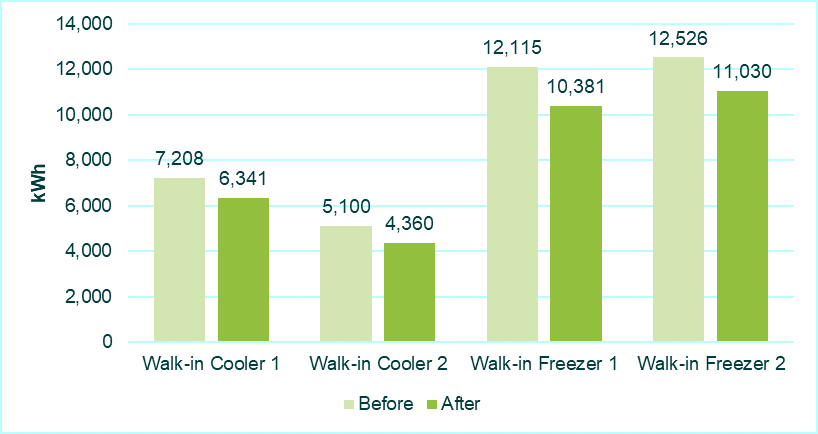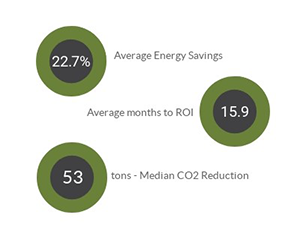At R3 Retail Development, we are always on the lookout for new ways to help customers save on energy costs. The eTemp product simulator temperature probe offers additional energy savings of an average of 20% for walk-in coolers, freezers, and refrigerated display cases. The payback time is around 12 months when this probe is applied to 3hp or larger condensing units.
Background
R3 Retail Development recently completed a short energy study to assess and quantify the potential energy savings in two university buildings through the implementation of eTemp temperature probes. The eTemp probe simulates the temperature of the actual refrigerated or frozen product to control the refrigeration system, unlike traditional refrigeration thermostats which sense the air temperature 
The space temperature in a refrigerated enclosure (walk-in coolers, freezers and display cases) fluctuates more rapidly than the actual temperature or the product in the space. Infiltration of outside air and the introduction of the addition of higher temperature product causes the space temperature to rise at a greater rate than product temperatures. Traditional refrigeration system controls rely on a space temperature thermostat to turn refrigeration on and off and generally run the refrigeration cycle more than necessary to maintain a desired product temperature range.
eTemp Savings
According to published case studies conducted by eTemp, using the eTemp probe can:
- Reduce energy consumption by 20%.
- Reduce compressor cycles by 50%, which can double the component life cycle.
- Produce tangible non-energy benefits such as reduced maintenance and deviation from product temperature setpoint.
The eTemp patented technology is NSF certified to accurately simulate product temperature using a proprietary material that is also food safe. The probes are used today in a wide variety of industries, including restaurants, convenience stores, hotels, schools, hospitals, refrigerated trucks, and warehouses. eTemp published projected savings of approximately 20% and simple payback time of fewer than two years for most applications and utility rates.
eTemp has developed an in-class study guide for educational institutions. This provides an avenue for student participation in the implementation of eTemp technology. Some educational facilities have recognized an annual CO2 reduction of more than 100 tons.
A single tree absorbs 48 pounds of carbon dioxide per year. At 2000 pounds per ton, the eTemp annual reduction of a median 53 tons, would require 2,208 trees to meet the same reduction.
Energy Study
Before evaluating the eTemp product’s energy savings potential, R3 conducted a detailed on-site audit of the university’s refrigeration equipment. Each walk-in was served by a stand-alone condensing unit with basic mechanical controls. The compressor nameplate capacities ranged from 9,010-12,600 Btu/hr. R3RD conducted a detailed load calculation for each walk-in. We made adjustments for the site-specific wall construction, product pull-down requirements, internal loads (lights, people, and evaporator fan motors). We also accounted for the infiltration of warm, moist air which occurs during door openings. The condensing units appeared to be oversized given the estimated loads. Oversized refrigeration systems contribute to compressor and condenser short-cycling which consumes more energy than necessary and reduces equipment life.
The eTemp technology simulates the temperature of the product stored in the walk-in instead of measuring air temperature. Most temperature sensors today measure air temperature. By mimicking the thermal inertia of the product stored in the walk-in, the eTemp allows the condensing unit to not respond to short-term fluctuations in air temperature caused by the opening and closing of the walk-in door. Instead, the condensing unit’s compressor runs less frequently for longer periods. We estimate the compressor will cycle 25-40% less after the installation of eTemp. Reducing the number of compressor cycles improves the unit’s operating efficiency. This potentially extends the equipment life, significantly reduces maintenance and potential replacement costs. The eTemp product has no moving parts, is easy to install and requires no maintenance.
Findings
Figure 1 summarizes the results of the evaluation, which even using conservative engineering assumptions, suggests the eTemp product has the potential to save 12-14% of each refrigeration system’s annual energy consumption. The systems being evaluated were only 1.5-2 HP compressors which extended the calculated payback period.
R3 used the Emerson Climate Technologies Product Selection Software and Energy Analysis module to estimate energy consumption of the coolers and freezers before and after retrofitting eTemp sensors. The bar chart in Figure 3 represents the calculated energy consumption output from the software.

Additional Simulations
Based on the study analysis and results, R3 ran simulations for utilizing the eTemp product on larger refrigeration systems. The chart below represents results based on compressor horsepower ranging from 3.5 to 7.5 hp (Figure 3). The estimated savings exceeds the installed product cost which brings the simple payback to 1.5 years or less. The basic return on investment can exceed 100%.

To learn more about energy-saving strategies for refrigeration, HVAC and lighting, click here, or contact us to discuss further.
About the Authors




